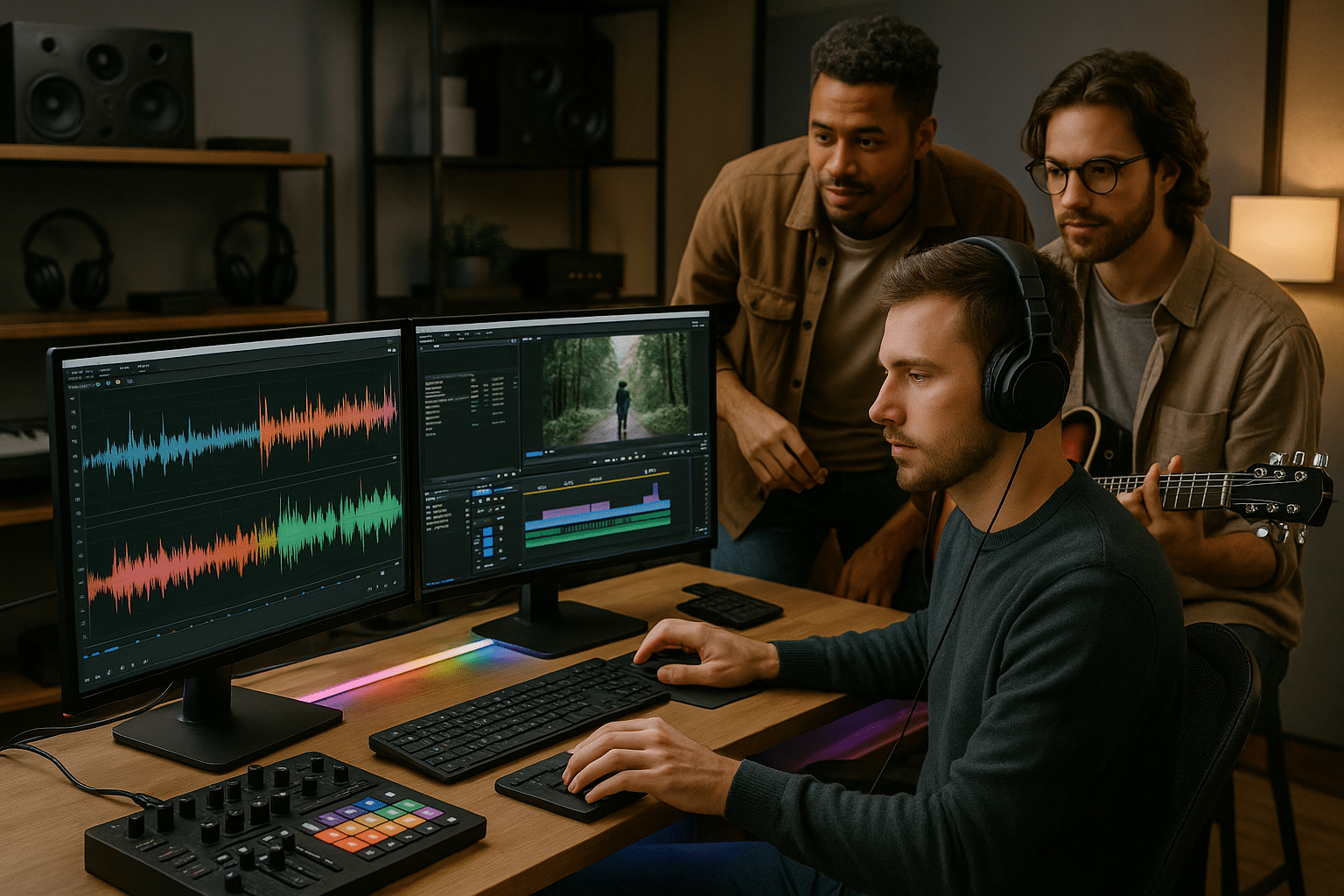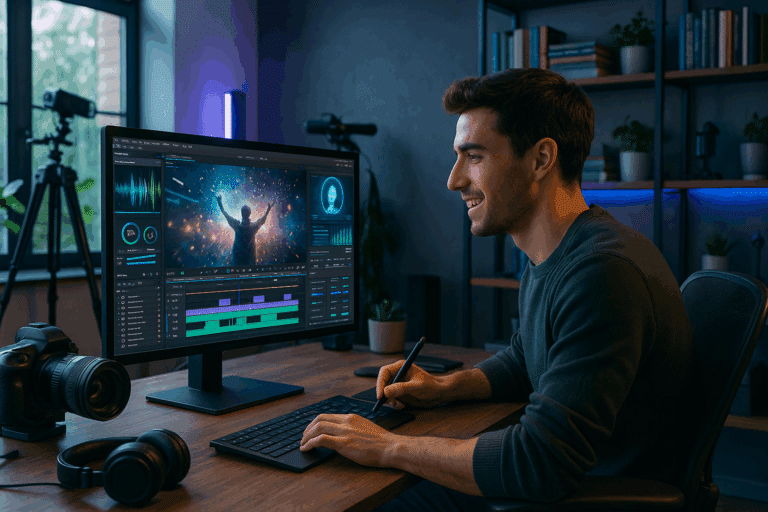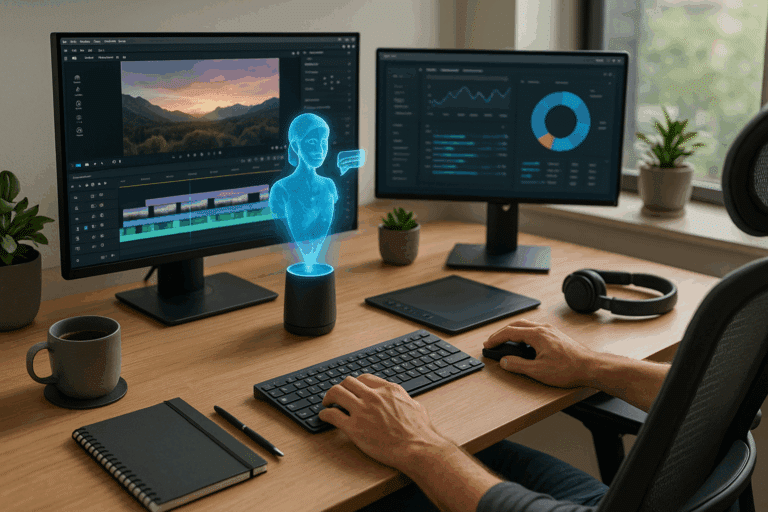Picture the protagonist engaged in a fierce battle or a suspenseful chase, all in pin-drop silence. Would it stir your emotions? The stark truth is, music is an integral part of visual storytelling, magnifying emotions, and cementing narratives. But, what if I told you that the harmony between music and video scenes could be further enhanced? And, AI holds the key to this symphony? Intriguing, isn’t it?
💡 The advent of Artificial Intelligence (AI) has revolutionized various industries, and the realm of music and video production is no exception. This piece delves deep into the role of AI in harmonizing the connection between music and video scenes, a phenomenon that’s stirring the pot in the industry. 🌟
🔍 In the forthcoming sections, we’ll explore the intricate details of how AI can autonomously compose music that matches specific scenes, adding an enriching layer of auditory experience to visual storytelling. We’ll also shed light on the significant strides in this direction, how it’s reshaping the future of video content creation, and why it could very well be the next big thing in the entertainment industry.
Moreover, you’ll get insights into the innovative AI algorithms that have been developed to understand, analyze, and respond to different video scenes with the appropriate musical score.🎼 These breakthroughs hold the potential to revolutionize the way we experience movies, ads, video games, and more, opening up a world of opportunities.
🎬 From the silent era of films to the present day, music has always been a powerful tool in cinema, reinforcing the narrative, evoking emotions, and enhancing the overall viewer experience. But, the task of scoring music that perfectly complements a particular scene has always been a time-consuming and labor-intensive process. However, AI is set to change the game, and how!
Imagine the potential of an intelligent system that can analyze a scene in real-time, understand the emotions it is trying to convey, and instantly compose a musical score that perfectly complements it. Sounds like something straight out of a sci-fi movie, doesn’t it? But, it’s not as far-fetched as it sounds. 🚀
AI-powered systems are being trained to ‘watch’ and ‘understand’ movies, TV shows, video games, and other forms of video content. They analyze various elements of a scene, such as the characters involved, their emotions, the setting, the plot development, and more. They then use this understanding to compose music that enhances the overall mood and feel of the scene. 🎵
We’re talking about a new era of video content creation, where AI becomes the virtual composer, adding a new dimension to storytelling. Sounds exciting, doesn’t it? So, whether you’re a music aficionado, a video content creator, a tech enthusiast, or someone curious about the latest developments in AI, this article is sure to pique your interest. 🌐
Now, without any further ado, let’s dive into the world of AI and its potential in harmonizing music with video scenes. Let’s explore how the symphony of technology and creativity is set to hit a high note. Get ready for an exhilarating ride! 🎉
The Intersection of Artificial Intelligence, Music, and Video: An Overview
Artificial Intelligence (AI) has profoundly reshaped various sectors, and the entertainment industry is no exception. The marriage between AI, music, and video scenes has created a new era of enhanced user experience, proving that technology can indeed be a melody to our senses. This article delves into how AI harmonizes the connection between music and video scenes, providing deep, insightful knowledge to satisfy your curiosity.
Before we dive into the details, it’s essential to understand the fundamental aspects of AI and its role in music and video production. AI is a branch of computer science that aims to simulate human intelligence in machines. In music and video scenes, AI can analyze and understand content to make recommendations or create entirely new content. It’s about enhancing the creative process, not replacing human artists.
Let’s start by exploring how AI is used in music production, and then we’ll delve into its application in harmonizing music with video scenes. This intricate process will be broken down for easier comprehension, and we will also present some practical examples to give you a clearer picture of the whole concept. So, sit back, relax, and journey with us into the fascinating world of AI in music and video scenes.
How AI Transforms Music Production
AI is revolutionizing the music industry in ways that were unimaginable just a few years ago. It’s not only about creating music – AI is now being used to master tracks, recommend songs, and even predict music trends. The result is a more efficient and personalized music experience for consumers and artists alike.
To provide a more tangible understanding, let’s examine some specific applications of AI in music production. These are AI composition, AI mastering, and AI recommendation.
AI Composition
AI composition involves using machine learning algorithms to create new music. These algorithms analyze vast amounts of music data, learning patterns, rhythms, and melodies to generate new compositions. A notable example is the AI platform, Amper Music, which allows users to create unique, professional-grade music in minutes. To get a feel of AI composition, you can watch the video “AI in Music Creation: A New Era?” by the YouTube channel, Two Minute Papers.
AI Mastering
Mastering is the final step in music production, where the track is polished to achieve the best sound quality. Traditionally, this process was done by human engineers, but AI is increasingly being used to master tracks. AI mastering platforms like LANDR analyze your music and use machine learning to apply the best adjustments, ensuring your track sounds as good as possible.
AI Recommendation
AI recommendation systems are an integral part of music streaming services like Spotify and Apple Music. These systems analyze your listening habits and use machine learning algorithms to recommend songs you might like. The result is a highly personalized music experience.
Now that we’ve seen how AI is transforming music production let’s move on to its role in harmonizing music with video scenes.
Harmonizing Music with Video Scenes using AI
Music plays a crucial role in video scenes, setting the tone and enhancing the viewer’s emotional experience. Traditionally, selecting the right music for a video scene was a manual, time-consuming process. But with AI, this process can be automated, resulting in perfectly harmonized music and video scenes.
AI can analyze the content of a video scene, understanding its mood and context. It can then select the appropriate music that perfectly fits the scene, enhancing the overall viewer experience. This can be particularly useful in film and video game industries, where music plays a vital role in setting the mood and engaging viewers.
For example, the AI platform, AIVA (Artificial Intelligence Virtual Artist), creates original soundtracks for films, commercials, and games. AIVA analyzes the video scenes and uses machine learning algorithms to compose the perfect music. This not only saves time but also results in more engaging and immersive video scenes. For a more detailed understanding of this, check out the video “AI in Film Scoring – A New Era?” by the YouTube channel, Film Score Analysis.
Comparing Traditional and AI-Enhanced Music-Video Harmonization
It’s essential to note that while AI brings efficiency and automation to music-video harmonization, it doesn’t replace the creativity and intuition of human artists. Instead, it serves as a tool that artists can use to enhance their creative process.
To better appreciate the impact of AI on music-video harmonization, let’s compare the traditional process with the AI-enhanced process.
| Aspect | Traditional Process | AI-Enhanced Process |
|---|---|---|
| Time | Time-consuming, often taking days or weeks | Efficient, often taking minutes or hours |
| Cost | Can be expensive, especially for high-quality music | Cost-effective, as AI platforms often charge a flat fee |
| Quality | Depends on the skill and experience of the human artist | Consistent, as AI algorithms learn from vast amounts of data |
As you can see from the table above, AI enhances the music-video harmonization process, making it more efficient, cost-effective, and consistent.
Conclusion
Artificial Intelligence is undeniably transforming the entertainment industry, particularly the music and film sectors. It’s exciting to see how AI can enhance the connection between music and video scenes, creating an immersive and engaging user experience. However, it’s important to remember that AI is not a replacement for human creativity. Instead, it serves as a tool that artists can use to enhance their creativity and streamline their processes.
So, the next time you watch a film or play a video game, take a moment to appreciate the harmonious music. Chances are, AI played a part in creating that perfect blend of sound and visuals.
If you’re interested in learning more about AI in music and video scenes, I recommend watching the YouTube video “The Role of AI in Music and Film” by the channel, Wired. It provides a comprehensive overview of this fascinating topic.

Conclusion
In conclusion, we have journeyed through the complexities of the realm of Information Technology and engineering, and I hope the voyage has been as enlightening for you as it has been fulfilling for me. I trust that the information shared has been valuable in enhancing your understanding of these intricate subjects. 🌐🔧
In our discussion, we revisited the vital role of software engineering in today’s digital society, its integral part in crafting the technology that powers our daily lives, businesses, and even our societies. This underlines the salience of software engineering as a field of study and profession.
We then delved into the multifaceted aspects of technical writing, and how it serves as a bridge between the technologists and the end-users. From user manuals to API documentation, from tech reports to white papers, the role of the technical writer is indispensable. It’s a critical skill for making complex technologies understandable and usable. ✍📘
In the ever-evolving landscape of technology, we also emphasized the importance of continuous learning and adaptation. As technologies emerge and evolve, so too must our understanding and our ability to communicate about them. It’s a never-ending journey, but one filled with immense potential and gratification. 🎓🚀
Remember, the knowledge acquired today is the power harnessed for tomorrow. I would like to encourage each of you to share your thoughts and experiences in the comments section below. Your insights could be the spark that ignites a new idea or solution. Moreover, feel free to share this article within your networks. Together, we can build a community of learners and leaders in the tech space. 💡🌍
For those who wish to delve deeper into these subjects, here are a few resources I recommend. Please note that these links are still active at the time of writing:
– [MIT OpenCourseWare: Introduction to Computer Science and Programming](https://ocw.mit.edu/courses/electrical-engineering-and-computer-science/6-0001-introduction-to-computer-science-and-programming-in-python-fall-2016/)
– [Coursera: Technical Writing Courses](https://www.coursera.org/courses?query=technical%20writing)
– [Stanford University: Software Engineering](https://see.stanford.edu/Course/CS309A)
Finally, I urge you to apply what you’ve learned, not just in your professional life, but also in your personal growth. The power of knowledge is only realized when it’s put into action. 💪🎯
I would like to express my gratitude for your time and engagement with this article. I am, as ever, at your disposal for further discussions or queries on the subject matter. Your journey of learning and growth is a shared adventure, and I am honored to be part of it. 👨💻🤝
Keep exploring. Keep learning. Keep growing. Until our next digital rendezvous, farewell! 🚀🌟👋
<p>[source]</p> <a href=”https://ocw.mit.edu/courses/electrical-engineering-and-computer-science/6-0001-introduction-to-computer-science-and-programming-in-python-fall-2016/”>MIT OpenCourseWare: Introduction to Computer Science and Programming</a> <a href=”https://www.coursera.org/courses?query=technical%20writing”>Coursera: Technical Writing Courses</a> <a href=”https://see.stanford.edu/Course/CS309A”>Stanford University: Software Engineering</a> <p>[source]</p>



